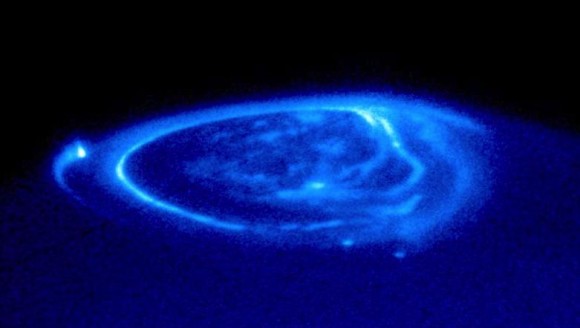
Astronomers announced today (July 29, 2015) that they’ve discovered the first aurora ever seen in an object beyond our solar system. It’s also the most powerful aurora ever seen. On Earth, we sometimes call an aurora the northern lights (or southern lights). Thanks to our spacecraft, we’ve seen auroras on other worlds in our solar system, too, for example on Jupiter. This newly found aurora is 10,000 times more powerful than any astronomers have witnessed before. It’s on relatively nearby object, a star-planet hybrid object or brown dwarf called called LSR J1835+3259. The scientists reported the aurora on this object in the July 30, 2015 issue of the journal Nature.
The National Radio Astronomy Observatory (NRAO) said today in a statement that this discovery reveals a major difference between the magnetic activity of more-massive stars and that of brown dwarfs and planets.
Astronomer Gregg Hallinan of the Caltech worked with an international team of researchers from the U.S., the U.K., Ireland, Germany, Russia, and Bulgaria to make this discovery. Hallinan explained the team’s conclusions when he said:
All the magnetic activity we see on this object can be explained by powerful auroras. This indicates that auroral activity replaces solar-like coronal activity on brown dwarfs and smaller objects.
Brown dwarfs, sometimes called “failed stars,” are objects more massive than planets, yet too small to trigger the thermonuclear reactions at their cores that power stars.
The astronomers said their observations of LSR J1835+3259 indicate that the coolest stars and brown dwarfs have outer atmospheres that support auroral activity, rather than the type of magnetic activity seen on more-massive and hotter stars.
The astronomers observed LSR J1835+3259 using the Karl G. Jansky Very Large Array (VLA) at radio wavelengths, along with the 5-meter Hale Telescope on Palomar Mountain and the 10-meter Keck Telescope in Hawaii at optical wavelengths. The combination of radio and optical observations showed that the object has characteristics unlike any seen in more-massive stars.
This discovery has implications for studying extrasolar planets, these astronomers said. The aurora the scientists observed from LSR J1835+3259 appears powered by a little-understood dynamo process similar to that seen on larger planets in our solar system. This process is different from that which causes the Earth’s auroral displays, which result from our planet’s magnetic field interacting with the solar wind. Hallinan said:
What we see on this object appears to be the same phenomenon we’ve seen on Jupiter, for example, but thousands of times more powerful.
This suggests that it may be possible to detect this type of activity from extrasolar planets, many of which are significantly more massive than Jupiter.

Bottom line: The brown dwarf LSR J1835+3259 has now been found to have a powerful aurora, the first aurora seen beyond our solar system and the most powerful aurora ever seen. This aurora is 10,000 times more powerful than any astronomers have witnessed before.











